Design Stamp for Use on Dry Wall
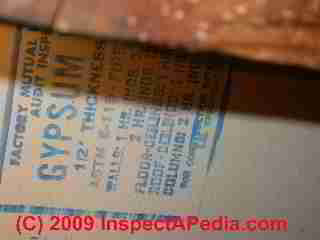 Drywall Identification
Drywall Identification
Stamps, markings, numbers help ID drywall products including Type C, Type X, Fire rated
- POST a QUESTION or COMMENT about drywall, gypsum board, "sheetrock" panels, brands, manufacturers
InspectAPedia tolerates no conflicts of interest. We have no relationship with advertisers, products, or services discussed at this website.
Guide drywall identification
Here we illustrate identifying stamps, labeling, paper imprints, and other details that can help identify specific drywall or gypsum board products.
These markings can help forming an estimate of building age and also help identify drywall products that might contain asbestos.
This article series discusses the identification and history of both modern and older interior building surface materials such plaster and lath, Beaverboard, and Drywall - materials that were used to form the (usually) non-structural surface of building interior ceilings and walls. Our page top photo shows hand-split wooden lath backing for a plaster interior wall.
We also provide an ARTICLE INDEX for this topic, or you can try the page top or bottom SEARCH BOX as a quick way to find information you need.
Identifying Stamps on Drywall Used for Interior Wall & Ceiling Surfaces
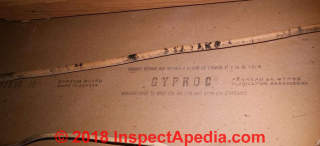 Index to photos of identification stamps and markings that help identify brands and types of drywall or gypsum board.
Index to photos of identification stamps and markings that help identify brands and types of drywall or gypsum board.
[Click to enlarge any image]
Since 2017, in North America, the following general format is used for drywall identification stamps (USGA 2017)
COMPANY NAME AAA2 0101010930 CCC
- COMPANY NAME of the drywall manufacturer (the company is permitted to encode this data using other characters)
- AAA 2 indicates manufacturing facility and production line number
- 0101010930 identifyies the date and time that the drywall was manufactured - in this example, 1 January 2001, at 09:30 hrs.
- CCC - 3-character country ID code as given in the table below
Watch out: depending on when it was manufactured, your drwywall may be un-marked or may use stamps and imprints that pre-date or for other reasons do not follow the 2017 guideline given above. We discuss and illustrate various forms of drywall or gypsum board product identification markings and tsamps below on this page.
ISO Country Codes | |
| ISO Code | Country Name (English) |
| BEL | Belgium |
| BRA | Brazil |
| CAN | Canada |
| CHN | China |
| COL | Columbia |
| DEU | Germany |
| DNK | Denmark |
| HON | Honduras |
| ITA | Italy |
| MEX | Mexico |
| USA | United States of America |
Notes to the table above
- Source: USA, IDENTIFICATION CODES on DRYWALL, USGA STANDARDS [PDF] (2017) Gypsum Association, 6525 Belcrest Road, #480 Hyattsville, MD 20782 USA, Tel: 301‐277‐8686 Website: www.gypsum.org - retrieved 2021/07/07 original source: American Gypsum Co https://www.americangypsum.com/sites/default/files/documents/GA-1000%20Identification%20of%20Gypsum%20Board.pdf
Gypsum Association Members 2017: American Gypsum Company Llc Certainteed Gypsum, Inc. / Certainteed Gypsum Canada, Inc. Continental Building Products Operating Company, Llc Georgia–pacific Gypsum Llc National Gypsum Company Pabco® Gypsum United States Gypsum Company / Cgc IncGypsum Association Members 2017 American Gypsum Company Llc Certainteed Gypsum, Inc. / Certainteed Gypsum Canada, Inc. Continental Building Products Operating Company, Llc Georgia–pacific Gypsum Llc National Gypsum Company Pabco® Gypsum United States Gypsum Company / Cgc Inc
- U.S. CPSC, NOTICE of INQUIRY: IDENITFYING LABELS for DRYWALL [PDF] U.S Consumer Product Safety Commission, 24 November 2009, retrieved 2021/07/07 original source: https://www.cpsc.gov/s3fs-public/pdfs/foia_drywalllabels.pdf
Focused on idenifying Chinese-made drywall as discussedat CHINESE DRYWALL HAZARDS
- USG US GYPSUM MANUFACTURING LOCATIONS [PDF] US Gypsum, retrieved 2021/07/07 original source: https://www.usg.com/content/usgcom/en/about-usg/worldwide-locations/manufacturing-locations.html
This document lists USG facilitites around the world and identifies what products are made, but does not include plant codes.
Other Methods for Identifying Drywall Manufacturer, Product, & Production Date

- Find the drywall production date stamp code on the back surface of the product: this production code can be seen on installed drywall IF the back surface of the drywall remains exposed, for example when only one side of a wall or ceiling has been finished. Even in a completed structure where all walls are fully enclosed, you might fiind the production data stamp on drywall in the attic space by lifting insulation there.
- Find the drywall end-tape: Find the manufacturer's name and product name and other information such as drywall dimensions and type on the paper end-tape found on the ends of drywall segements. You will have trouble finding the end tape after drywall has been installed, because usually those ends are fastened to wall studs or wall sill and top plates where the 2x lumber obscures the tape.
The end tape is also color-coded on modern drywall products, allowing quick identification of drywall thickness and type, such as fire-rated, mold-resistant, moisture-resistant.
- Find other printing on the back of the drywall: some drywall products such as CertainTeed's GlasRoc sheathing and Diamondback don't use end-tapes but have text printed across the whole board surface, indicating the manufacturer, product, and other data such as fire-rating.
Here is an end-tape from USG's Sheetrock drywall brand that we think was produced in the 1930s - cited and discussed below on this page

- Find a stamp along the tapered drywall edge: modern drywall is often stamped with the manufacturer's name along the paper-enclosed tapered long-edge. These edges, too, will be impossible to see once drywall has been installed. Unless you remove it.
- Find patent numbers on the drywall end tape or on inked stamps on the drywall back: even when end tapes are only partially available or when only partial drywall data stamps are visible, patent numbers can often point to the manufacurer.
Article Contents
- BESTWALL DRYWALL IDENTIFICATION
- CELOTEX GYPSUM BOARD / DRYWALL
- CERTAINTEED GYPSUM BOARD
- DOMTAR GYPSUM DRYWALL
- FM FACTORY MUTUAL DRYWALL
- GENSTAR GYPSUM LTD.
- GYPROC DOMTAR CANADIAN GYPSUM BOARD
- GYPROC IGNIFUGE FIRE RATED DRYWALL
- NATIONAL GYPSUM DRYWALL
- UL UNDERWRITERS LABORATORY STAMP on DRYWALL
- US GYPSUM DRYWALL
- EXTERIOR-USE GYPSUM BOARD
- ROCK LATH GYP LATH PLASTER BASE
- SHEETROCK® TYPE X FIRE RESISTANT USG Drywall
- TYPE C DRYWALL vs Type X DRYWALL
Bestwall Drywall Identification Stamps
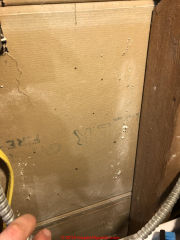 Thanks to reader Nick for these photos giving some hints at identifying Bestwall gypsum board (2020/01)
Thanks to reader Nick for these photos giving some hints at identifying Bestwall gypsum board (2020/01)
Question:
2020/01/16 Nick said:
Recently began to take down some old gypsum and I noticed that it said "Certain-Teed Beaver Gypsum Fireproof. Does anyone know anything about this?
Reply:
We describe Bestwall in both its original composition (wood product and gypsum dating before 1920) - not an asbestos-containing product
and in later production by Certainteed as a fireproof gypsum board that contained asbestos.
See details at BESTWALL DRYWALL ASBESTOS
It would be helpful if you could post a photo of the stamp as well as of the material itself.
Your gypsum board may be quite old - dating probably from the 1950s. Certainteed purchased Beaver Products in 1928.
Certainteed's Bestwall Gypsum board contained asbestos through 1976 or possibly 1977 depending on when the product installed in that year may actually have been manufactured. You should also consider that joint compound used with the product may also have contained asbestos.
Reader follow-up:
Here are some photos.
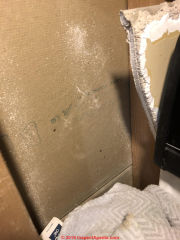
Reader Follow-up:
The text I can read is ""Certain-Teed Beaver Gypsum Fireproof"
Below, US Patent Numbers give an age range, the assignee (U.S. Gypsum) for this gypsum board, and can be searched for the use of "asbestos" (it does not appear). These patents are listed with more detail
at BESTWALL DRYWALL ASBESTOS
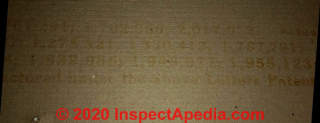
Celotex Drywall Identification Labeling
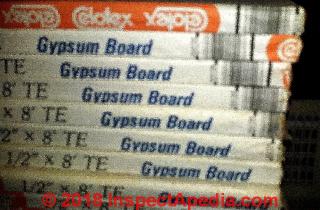
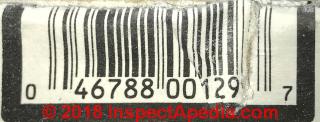
Above: Celotex® Fiberglass-reinforced drywall identification labels & UPC
Our photos show modern as well as antique identification stamps or labels that may be found drywall products used for interior walls and ceilings.
[Click to enlarge any image]
Contact Celotex:
- Celotex, Lady Lane Industrial Estate, Hadleigh, Ipswich, Suffolk, IP7 6BA UK Tel: 01473 822093
Celotex UK produces Roofing, Flooring, and Wall insulation products - Celotex Asbestos Settlement Trust: http://www.celotextrust.com/ , On October 12, 1990, Celotex Corporation and Carey Canada Incorporated filed for reorganization under Chapter 11 of the U.S. Bankruptcy Code. Celotex Asbestos Settlement Trust. P.O. Box 1036. Wilmington, Delaware 19899-1036
CertainTeed Drywall Identification & Product Stamp Decoder
Current CertainTeed drywall includes a date stamp that can be decoded to also show the manufacturing plant.
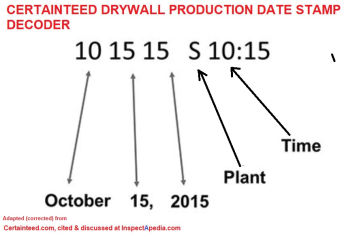
Above: courtesy of CertainTeed Corp., retrieved 2021/08/26, adapted with minor edits from original source: "HOW DO I IDENTIFY THE BOARD I AM USING? (HOW CAN I TELL WHO THE MANUFACTURER IS AND WHEN IT WAS MADE?)" , www.certainteed.com/drywall/how-do-i-identify-board-i-am-using-how-can-i-tell-who-manufacturer-and-when-it-was-made/
CertainTeed Drywall Stamp (1951)

Above, fiberglass-reinforced drywall, probably a CertainTeed® product, as the patent number assigned this product design to that company. This product used fiberglass as a reinforcement and it probably does not contain asbestos.
Details about this particular drywall, described in the CROCE DRYWALL PATENT No. 2,681,863 [PDF] (1951), are given
at ASBESTOS in DRYWALL [web article].
Below is a photo of Certain-teed Products Corporation's Beaver Gypsum Lath, "Fire-Proof" "rock lath" courtesy of InspectApedia.com reader Z Headman & Zach, posted originally as a comment at the bottom of this page.

More photos of CertainTeed gypsum board and Certain-Teed or Beaver drywall identification stamps and photos are at
CERTAINTEED DRYWALL ASBESTOS
What CertainTeed currently says about how to identify Type X Drywall
Both regular and Type X gypsum board are covered under the ASTM C 1396, gypsum board standard specification.
Regular drywall has naturally occurring fire resistance due to the presence of gypsum in the core but is not fire rated. Type X drywall has special core additives that allow it to be used in fire rated designs and usually comes in 5/8" thickness.
Type X drywall products will have a UL/ULC Marking printed on the back of each board identifying it as a fire-resistance rated board. - Certainteed, retrieved 2021/07/17 original source: https://www.certainteed.com/drywall/what-difference-between-regular-and-type-x-gypsum-board/
and
Fire rated gypsum drywall is more fire resistant because it contains glass fiber reinforcement and other additives within its specially formulated gypsum core to help it hold up longer to a fire exposure.
Fire rated drywall is referred to as "Type X" and must be third-party certified by an independent testing and listing agency such as UL (Underwriters Laboratories Inc.) and ULC (Underwriters' Laboratories of Canada) to meet the fire performance requirements prescribed in the ASTM C1396 (CAN/CSA-A82.27) Standard Specification for Gypsum Board. - 2021/07/17 Certainteed, https://www.certainteed.com/drywall/what-fire-rated-gypsum/
Factory Mutual & FM Drywall Stamps

[Click to enlarge any image]
Above: Factory Mutual Audit Inspection Stamp on 1/2" gypsum wallboard that is 1-hour factory rated.
Below: FM Gypsum brand wallboard, type FSW giving fire ratings.
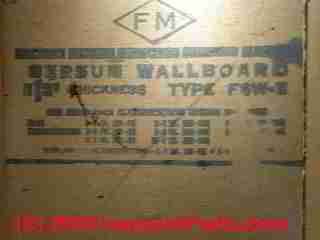
Contact FM Approvals: Website: https://www.fmapprovals.com, Worldwide office locations website: https://www.fmapprovals.com/office-locator FM Approvals continues to test and certify key products related to property loss prevention. Our dedication to innovation over the years has resulted in numerous technical advancements, including low smoke generation wall panels, clean room materials, suppression mode sprinkler protection and water mist systems.
Website Excerpt:
Domtar Gyproc, Canadian Production Drywall Identification Stamps

Question: does this Domtar wallboard contain asbestos?
2020/01/03 Tyler Garneau said:
Domtar 92050600:0246 Rippon
Wall board type 9
Issue number c-3189
Wondering the age and if contains Asbestos
Reply: Gyproc Domtar FIREGUARD GYPSUM BOARD Type 9 Wallboard
As this is Domtar Fireguard it may contain asbestos.

See details at
ASBESTOS in CANADIAN DOMTAR GYPROC DRYWALL?
On 2018-09-05 by Ivan Garcia
1949 home. Concerned this drywall and/or mud May have asbestos.
Previous owners said they did 3 renovations on the basement- in the mid 80s then mid 90s, then mid 2000s. Can the age of this drywall be identified by the printing on it?
Thank you for an interesting and useful question, Ivan.
Indeed some Gyproc, particularly Ignifuge Fire Resistant Gyproc may contain asbestos. But yours may be an entirely different product.
It might be that the production number, partly visible in the right end of your photo as it appears, is a production run number that in turn might be able to be decoded to a date, but I have not yet found an age decoder for Gyproc stamps and I'm doubtful.
When faced with the "how old is it" question for building materials, and when there is not a clear date stamp or code, I look for external clues of the age of the material, in this case the age of your Gyproc including
Age of the building - that sets a floor under the probable age of its materials of construction
Age of surrounding materials, particularly those that are likely to have been put in place at the same time
Dates of renovation work, modifications, repairs: in your case mid 80s then mid 90s, then mid 2000s.
Location of the building: country and city, since when addressing your asbestos question we know, for many countries, about when asbestos use in drywall and drywall mud (joint compound) ceased.
In your photo the fabric-covered electrical wire is likely from original construction. The wooden stud looks newer than 1949 as it is so light in color, but I see what looks like paint or something in the lower right corner of the photo that may be older material.
If the Gyproc in your photo was part of the basement renovation work then you have an "oldest" date of 1985. For North America that's likely to be post-asbestos.
See these two articles
CANADIAN DRYWALL ASBESTOS
IGNIFUGE GYPSUM BOARD ASBESTOS?
Wow-
Thanks for the prompt and thorough reply. Great info.
Country is Canada- province Manitoba, city Winnipeg.
I will get a better shot of the number stamped at the right end of the photo. Thank you for looking into an age decoder for Gyproc Stamps.
Regards,
Ivan
Here is a picture of the production code number. Do you think a decoder could be found for it?
Regards.
Ps, I found that on some of these sheets, there is a blue Domtar logo on the edge.
Thanks again.
Ivan
Do you think there's a chance that decoder could be out there?
I haven't been able to find one.
IMO it seems likely that the company would have known what their number-stamps meant; but if a company is no longer around it can be difficult to find that documentation unless you find it in a legal proceeding, litigation, or on occasion, a patent disclosure.
The above Q&A were posted originally at ASBESTOS in DRYWALL
Genstar Gypsum Limited (Canada) Drywall Identification Stamps
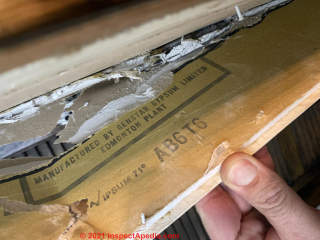 Question: does this Genstar Gypsum Ltd. wallboard contain asbestos?
Question: does this Genstar Gypsum Ltd. wallboard contain asbestos?
(Jan 4, 2021) Jamie V said:
Can anyone tell me if this wallboard contains asbestos before I start tearing it apart more?
Genstar Gypsum Ltd. Edmonton Alberta Genstar- AB6T6
Thanks
Moderator reply:
Jamie
Thank you for the question and photo of Genstar Gypsum Ltd. drywall. .
Genstar produced, among other products, a Type X Gypsum Board that was referred-to in
this CANADIAN STANDARDS DIRECTOR'S INTERPRETATION for Type X Gypsum Board 1991 [PDF]
as having a "Fire Performance Rating". Type X wallboard was described in Canadian Standard CSA A82.27-M1977, "Gypsum Board Products". This document includes among its listed products, Genstar Gypsum Limited - Type TRF-3 wallboard.
Nothing in the document we cite here refers explicitly to the use of asbestos in the wallboard's composition, nor was asbestos explicitly excluded.
Watch out: However Genstar is indeed included among companies listed in litigation concerning asbestos in drywall products and drywall mud along with a number of asbestos suppliers. See ABENDROTH v. Hamilton Materials, Inc., a California corporation, Respondent [PDF]
Except:
The trial court granted summary judgment in favor of defendant, concluding that there was no genuine issue of material fact as to whether plaintiff was exposed to any asbestos-containing product manufactured by defendant. ... The subject of the motion for summary judgment in this case was whether plaintiff was ever exposed to an asbestos-containing product that was manufactured by defendant....At issue here is whether any of the "mud" used by plaintiff and manufactured by defendant contained asbestos.
During the relevant time period, defendant manufactured both taping compounds and finishing compounds, which were designed to be used in conjunction with each other. Defendant admits that many of its taping compounds during the relevant time period contained asbestos.
Although all of defendant's taping compounds contained asbestos between 1959 and 1974, its "topping compound," also known as "finishing compound," did not. Defendant's finishing compound was its best-selling product.
Watch out: Therefore, until we find other composition data for Genstar gypsum board, It would be reasonable to treat Genstar Gypsum drywall as well as drywall compound used in wall assemblies using this product as presumed to contain asbestos, or if you face a significant demolition cost, to have a sample tested for asbestos.
Genstar Gypsum Limited was a Canadian company operating at least in the 1970s if not earlier, and reported as having incorporated in Canada 1978-03-01, and sold by holding company Imasco to Domtar, Inc., for $241 million, as reported in the LA Times on 14 October 1986. The company was dissolved in 1991 as I report below.
In 1982 this REPORT on GEOPHYSICS, STRIPPING and GEOLOGICAL EVALUIOTN of MINERAL PROPERTY at LUSSIER RIVER B.C., FORT STEELE MINING DIVISION [PDF], prepared for Genstar Gypsum Limited by Reimchen Surficial Geology Ltd. describes the subject property: we note that the word "asbestos" was not found in this report.
In 1985 the company was still operating in Canada and was described as
Genstar Corporation (its Armacis Island gypsum plant), New Westminster, BC - Manufactures and sells gypsum wallboard and related products. [Receiving an investment from Westroc Industries Limited, Mississauga, ON, CDA (UK)] - source: https://www.ic.gc.ca/eic/site/ica-lic.nsf/eng/lk-38509.html
Here is the text from the 1986 LA Times news report on Genstar Gypsum's sale:
The Montreal-based tobacco and retailing company said it had agreed to sell the unit for $241 million in cash to Domtar Inc., a diversified company also based in Montreal. Genstar Gypsum, based in Irving, Tex., is a subsidiary of Genstar Corp., which was bought by Imasco earlier this year for $1.9 billion. Imasco, [...] has been selling Genstar's assets except for Canada Trust co Mortgage Corp., a financial services business.- retrieved 2021/01/10 original source: https://www.latimes.com/archives/la-xpm-1986-10-14-fi-3278-story.html
Interestingly, the next year, on 25 February 1987, Genstar Gypsum Products Company was among other defendants (Domtar and Flintkote) named in an anti-trust suit against acquisition filed by the United States Anti Trust Division in Washington, D.C. At that time Genstar was described as a U.S. company:
Genstar Gypsum Products Company transacts business, maintains offices, and is found within the Northern District of California.- source: United States of America v. Domtar et als, Flintkote, and Genstar Gypsum [PDF] retrieved 2021/02/10 original source: https://www.justice.gov/atr/case-document/file/984636/download
Here is a record of the company's dissolution:
GENSTAR GYPSUM LIMITED is a company from VANCOUVER BC Canada. The company has corporate status: Dissolved by the corporation (s. 210)on 1991-05-03.
This business was incorporated 42 years ago on 31st March 1978. It was dissolved on 3rd May 1991 after trading for 13 years. - source: Companies of Canada, retrieved 2021/02/10 original source: https://www.companiesofcanada.com/company/028816-1/genstar-gypsum-limited
Last-known addresses:
Genstar Gypsum Limited, 1220 weber centre 5555 ca Edmonton Alberta T6H4J9 Canada and Genstar Gypsum Limited, 1040 W. Georgia St., 19th Floor, Vancouver BC, V6C 4H3, Canada, dissolved in May 1991.
Don't confuse the Genstar Gypsum company with the similarly-named Genstar Development Company is a real estate development company with projects in Calgary, Edmonton, and Winnipeg, but the brand is more than 50 years old. Regarding Genstar Development and its subsidiary BACM Industries and others operated as land developers in western Canada and that this Genstar was responsible for a housing crisis in Vancouver B.C. (Gutstein 1975)
- Gutstein, Donald. Vancouver Ltd. Vol. 33. James Lorimer & Company, 1975.
You will also want to review
ASBESTOS in CANADIAN DOMTAR GYPROC DRYWALL?
and
ASBESTOS in CANADIAN DRYWALL
Gyproc® Ignifuge Fire-Rated Drywall Identifying Stamps
Below: a stamp identifying Ignifuge Gyprock® fire protective gypsum board, a Canadian product.
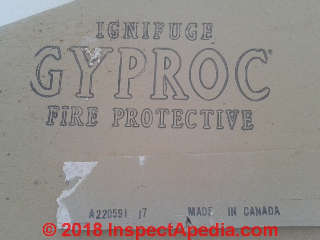
Details about Ignifuge-stamped gypsum board are
at IGNIFUGE GYPSUM BOARD ASBESTOS?
and
GYPROC DOMTAR CANADIAN GYPSUM BOARD
Contact: Saint Gobain Gyproc Corporation, Saint-Gobain, Website: http://www.saint-gobain-gyproc.com/ Saint-Gobain S.A. is a French multinational corporation located in Courbevoie, France.
Below, a UL classified Gypsum Board Fire Resistance Stamp indicating Type C 5/8" fire-rated gypsum board approved in both the U.S. and Canada. This example indicates that the word Ignifuge will not appear on all fire-retardant treated or fire-rated gypsum board products.
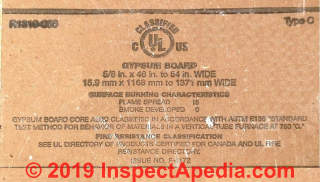
National Gypsum Co. Drywall Identifying Stamps & Labels
Below: National Gypsum drywall stamp on a U.S. home built in Ann Arbor MI in 1958. The image was contributed by an anonymous reader.
We think this drywall was installed in an Ann Arbor Michigan home built in 1958 during basement renovation, possibly in the 1970's. Readers recognizing this stamp are invited to CONTACT us to offer more information.

According to our reader, the gypsum board shown above was tested and found to contain NO asbestos. [Private email 2018/03/29 ]
National Gypsum produced and sold a number of asbestos-containing drywall / gypsum board products until the early 1970's, may under the Gold Bond name, also Insul-Best panels.
Details are at ASBESTOS PRODUCING COMPANIES & TRUSTS
Also see
- National Gypsum, GYPSUM BOARD SYSTEMS Gypsum Construction Guide [PDF] 12th Ed., National Gypsum Co., retrieved 2021/07/07 describes the company's current products such as the Gold Bond brand gypsum board product series, also Gridstone ceiling panels.
Underwriters Laboratory Drywall Stamp
Below: an Underwriters Laboratories wallboard fire-rating stamp
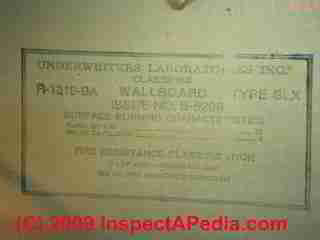
U.S. Gypsum Drywall Identifying Stamp
Below: a United States Gypsum drywall stamp from an older home.
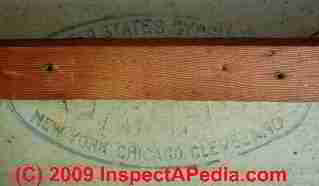
Also see additional drywall identifying number stamps found
at DRYWALL GYPSUM BOARD Used for Exterior Wall Sheathing.
Where there indoor environmental concerns or corrosion damage to electrical wiring, copper pipes, air conditioning equipment, etc. be sure to
see CHINESE DRYWALL HAZARDS.
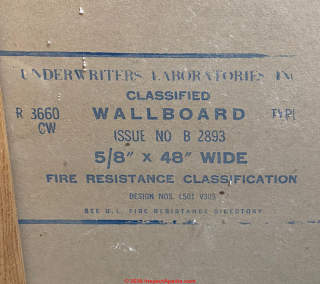
Above: A drywall fire rating stamp, courtesy of IAP reader NAR 7 Aug 2020
Drywall with a stamp indicating R 3660 means that the drywall meets ASTM C1396 Standard Specification for Gypsum Board
Abstract: Abstract
This specification covers gypsum boards which include the following: gypsum wallboard for use on walls, ceilings, or partitions and that affords a surface suitable to receive decoration; pre decorated gypsum board for use as the finished surfacing for walls, ceilings, or partitions; gypsum backing board, coreboard, and shaftliner board for use as a base in multilayer systems or as a gypsum stud or core in semisolid or solid gypsum board partitions, or in shaft wall assemblies;
water-resistant gypsum backing board to be used as a base for the application of ceramic or plastic tile on walls or ceilings; exterior gypsum soffit board for exterior soffits and carport ceilings that are completely protected from contact with liquid water; gypsum sheathing board for use as sheathing on buildings; gypsum base for veneer plaster; gypsum lath for use as a base for gypsum plaster application; and gypsum ceiling board for interior ceilings and walls. Gypsum board shall consist of a noncombustible core, essentially gypsum, surfaced with paper bonded to the core.
The specimens shall comply with the following required physical properties: core, end, and edge hardness; straightness of the edges and ends; length; tapered edge depth; flexural strength; humidified deflection; nail pull resistance; permeance; water resistance; and surface water absorption.
Current types of fire-resistant drywall, also referred to as Fire Board, X Board or Type X drywall, use glass fibers and are 5/8-inch thick.
Sheetrock® Brand Drywall a USG Product: Type X R-1319 Fire-Resistant drywall
Below are two drywall stamps, one of which includes US Gypsum's SHEETROCK ® Brand, found in a Los Angeles California home built in 1972 - adapted from photos from reader ML.
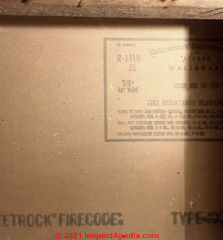 ...
... 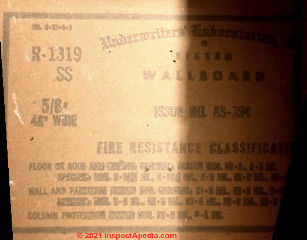
This 5/8" drywall is stamped "SHEEETROCK FIRECODE Type "X" and includes additional UL Stamps (in the rectangle) coded R-1319 SS 5/8" 48" Wide Fire Resistance classification. Also marked Issue No. AS-794 .
Drywall Gypsum Board Used for Exterior Wall Sheathing
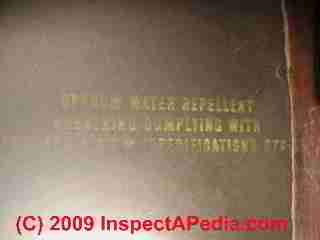
We estimate that from 1950 to 1965 gypsum board was used as exterior wall sheathing on a variety of buildings, especially low-cost structures and in panelized construction as we explain along with our photographs shown below.
We also find gypsum board sheathing used on some roofs, believe it or not.
In some applications a water repellent paper was used to improve the product's durability, as we show in this wall cavity side photograph of identifying marks on gypsum board sheathing.
Details: as water-resistant gypsum panels were widely used for exterior wall and roof sheathing we discuss this material separately
at SHEATHING, GYPSUM BOARD
Also see DRYWALL MOLD RESISTANT for an interior drywall reported to resist mold growth.
Gypsum Board Lath Sheets Used for Plaster Walls & Ceilings = Rock Lath, Plaster Lath, Rock Lathe & Button Board

Details are found at GYPSUM BOARD PLASTER LATH SYSTEMS.
Differences Among Type C & Type X Drywall & Type X Shaftliner Drywall
Both original Type X drywall and newer Type C drywall are fire-resistant products.
Type C has improved fire resistance over Type X.
Type X-Shaftliner drywall is a still-thicker fire-resistant drywall used in areas where extra fire-resistance is needed such as in elevator shaft walls and area separation firewalls, typically in commercial buildings.
Summary of Fire-Resistant Drywall Types | |||
| Drywall Type | Thickness | Fire Rating | Comments |
| Type C Drywall | 1/2" (12.7mm) or 5/8" (15.9mm) | 1-hour | Improved Type X More fiberglass |
| Type X Drywall | 5/8" (15.9mm) | 1-hour | |
| Type X Shaftliner Drywall | 1" (24.5 mm) | 1-hour+ | Notes 5, 6 |
Notes to the table above
- Source: CertainTeed Corp. "Types of Fire Rated Gypsum", CertainTeed Corporation, retrieved 2021/07/17 original source: https://www.certainteed.com/drywall/what-fire-rated-gypsum/
(2016)
CertainTeed TYPE C GYPSUM BOARD PRODUCT DATA [PDF] (2016) CertainTeed Corporation P.O. Box 860 Valley Forge, PA 19482 USA Tel: Professional: 800-233-8990 Consumer: 800-782-8777 Website: www.certainteed.com , retrieved 2021/07/17 original source: https://www.certainteed.com/resources/CTG_TypeC_Eng.pdfExcerpt: CertainTeed Type C Gypsum Board is an interior gypsum board consisting of a solid set, fire-resistive, Type C gypsum core enclosed in ivory-colored face paper and a strong liner back paper. CertainTeed Type C board features a specially formulated Type X core providing superior fire performance when used in specific fire-rated Type C assemblies. Long edges are slightly tapered, allowing joints to be reinforced and concealed with joint tape and joint compound.CertainTeed TYPE X GYPSUM BOARD PRODUCT DATA [PDF] (2017) CertainTeed, Op. Cit., retrieved 2021/07/17 original source: https://www.certainteed.com/resources/CTG_2337_TypeX_%20DSS_EN.pdf
Excerpt: CertainTeed Type X Gypsum Board is an interior gypsum board consisting of a solid set, fire-resistive, Type X gypsum core enclosed in ivory-colored face paper and a strong liner back paper. CertainTeed Type X board features a specially formulated core providing fire resistance ratings when used in tested assemblies. Long edges are slightly tapered, allowing joints to be reinforced and concealed with joint tape and joint compound.
CertainTeed M2Tech SHAFTLINER TYPE X GYPSUM BOARD PRODUCT DATA [PDF] (2009) CertainTeed Corporation P.O. Box 860 Valley Forge, PA 19482 USA Tel: Professional: 800-233-8990 Consumer: 800-782-8777 Website: www.certainteed.com , retrieved 2021/07/17 original source: https://www.certainteed.com/resources/CTG_CT012_M2TechShaft_E.pdf
CertainTeed FIREWALLS INFORMATION for Canada [PDF] CertainTeed, Op. Cit., retrieved 2021/07/17 original source: https://www.certainteed.com/resources/CTG-2950 Firewalls Info Sheet E R2-14-FINAL.pdf
Excerpt:
M2Tech® technology combines a specially formulated, fire resistive noncombustible core, enclosed in a moisture and mould resistant paper which is 100% recycled with double beveled edges for ease of installation. M2Tech achieves a score of 10 for mould resistance as per ASTM D3273, the best possible scores for these tests.Note that CertainTeed and probably other drywall manufacturers provide additional product data sheets and environmental products declarations offering varying details describing their products produced by different manufacturing facities in different locations and serving different countries, states or in Canada, provinces.
Example:
CertainTeed TYPE X GYPSUM BOARD ENVIRONMENTAL PRODUCT DECLARATION [PDF] (2015) for CertainTeed Gypsum manufacruring facilities based at Toronto, Ontario, Canada, retrieved 2021/07/17 original source: https://www.certainteed.com/resources/CTG_TypeX_EPD_Toronto.pdf
- Typical 1-hour fire-rated wall construction: Type X or Type C drywall installed on both sides of 2x4 (nom.) wood stud walls 16" o.c. or 3 5/8" steel stud walls 24" o.c. as per various building codes
- Typical residential locations requiring fire-rated walls/ceilings include around boiler or furnace rooms, rooms locating a wood stove or coal stove, and on the common wall and adjacent ceiling of garages attached to living space
- Typical commercial locations requiring fire-rated walls/ceilings include most building walls where fire partitions or assemblies are specified, particularly stairwells, fire separtion walls, etc.
- Shaftwall drywall system Codes / Standards:
ASTM C1396, C475, C645, C754, C840, C1002, C1047, E84, E119; CAN/ULC-S101, CAN/ULC-S102, CAN/CSA-A82.27, GA-600, GA-216, GA-238; UL U417, ULC W446; ICBO ES ER-3579; NER-506; ICBO ES ER-4924
- Area Separation Firewall System Codes / Standards:
ASTM C1396, C475, C645, C754, C840, C1002, C1047, E84, E119; CAN/ULC-S101, CAN/ULC-S102, CAN/CSA-A82.27, GA-600, GA-216, GA-238; UL U366, ULC W311
- Additional Fire Resistant Drywall Identification - paper colors: besides from the identifying stampings or labeling cited above on this page include the color of the paper covering the drywall sides
- CertainTeed Type C fire resistant drywall paper: solid set, fire-resistive, Type C gypsum core enclosed in ivory-colored face paper and a strong liner back paper.
- CertainTeed Type X Gypsum Board paper: solid set, fire-resistive, Type X gypsum core enclosed in ivory-colored face paper and a strong liner back paper.
- CertainTeed Type X Shaftliner paper: Heavy moisture and mold resistant light blue-grey colored face and back paper
Reader Comments & Q&A
 @Phyllis,
@Phyllis,
Without knowing the manufacturer we can only guess - since manufacturers may vary in how the use production date codes.
Look for another identifying stamp, or if the ends of drywall are visible anywhere, look at the paper end-tape to identify the product manufacturer and specific item.
But a typical drywall manufacturing date code format interpretation for your data would be as follows:
12 = Month: December
10 = Day: 10th
7 = year: 2007
W 10 M = plant code and production time, such as "Washington 10 AM Production Line "M"
Above is an example of one of these contemporary Drywall date code translations provided by Certainteed at www.certainteed.com/drywall/how-do-i-identify-board-i-am-using-how-can-i-tell-who-manufacturer-and-when-it-was-made/
Other manufacturers use similar but not necessarily identical production date and time stamp formats, as we describe above on this page.
Code number on sheetrock
12 10 7 W 10 M
Doesn't conform to the code as mentioned. Do you have any reference to manufacturing date
Thank you
@Kirsten,
Thank you for the follow-up as I will help other readers. If I understand the question correctly you are working on the cavity side of the drywall that we are discussing.
In that case one must ask if the building department would have accepted you installing fire rated gypsum board either in the cavity against the existing drywall or on the other , exposed side of the same wall.
@inspectapedia.com.moderator, Thank you for the response! Bummer the patent couldn't be tied to a fire rating. The drywall you see is the back of my kitchen with a whole row of kitchen cabinets behind them. So to replace that drywall, I would need to tear out the kitchen cabinets.
However, I had some success with my building department who is going to allow me to use intumescent paint in that wall cavity and not make me replace with type X. So paint in the cavity and then type x on top to reclose the wall (if that makes sense). Woohoo! Thanks for the help. This site has been a great resource for me through this project!
 @Kirsten,
@Kirsten,
A quick patent search finds
- Johnson, Gordon C., and Samuel Sterman. "Process for sizing paper with epoxy silicone and resulting products." U.S. Patent 3,431,143, issued March 4, 1969.
- David, Bieri, and Edward S. Coia. "Gypsum wallboard and method for producing same." U.S. Patent 3,389,042, issued June 18, 1968.
Neither of these patents address fire resistance nor even use the word "fire" in the patent disclosure. They do give a floor to the possible age of your drywall. It would not have been made before the dates of patents whose number are stamped on the product.
Perhaps if you say more about why you'd have to demolish an entire kitchen wall we can offer more advice. That sounds, frankly, a bit extreme.
Seems more-likely you could, at worst, add a layer of fire-rated drywall somewhere on the wall structure.
I am trying to ensure there is a firewall (fire rated drywall/type x) between my two units so I can reclassify my property as a duplex. We have had luck in finding most drywall on the shared wall is Fire Rated. However, there are a few sheets that have us stumped as we can only find patent numbers.
If we can prove these are fire rated, it would allow us to avoid demo-ing a whole wall in our kitchen. Does anyone know if there is a database or somewhere where I can find info on these patent numbers? I have had no luck on google. It is 5/8" drywall. Any help appreciated. Thanks!
@Tyler,
It could contain asbestos, depending on the age of your drywall.
Look for manufacturer's identification in other stamps on your drywall and let us know what you find.
Please see details at ASBESTOS in DRYWALL https://inspectapedia.com/hazmat/Asbestos_in_Drywall.php
Does this drywall contain asbestos?

@Kirsten,
I agree it's possible that that little "X" might indicate fire rated drywall on a 1970s gypsum board, but the rest of the numbers look like a production run not a manufacturer identification stamp. I wouldn't rely on that X , I would look for other stampings identifying the manufacturer and standards that applied.
Also see if you can find the printed end tape on the drywall ends if they're exposed anywhere in your duplex.
I need to prove or add type x drywall on some common walls in my duplex. I found this marking. Does anyone know if that small "x" at the end is proof that this is type x? We have found other areas with more obvious type x. Likely from the 1970s.
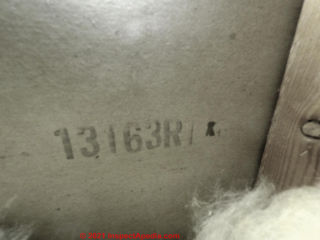

@Matt,
Translating identification stamps on drywall is made a bit tricky in part because depending on the age of the product its ID stampings may comply with different standards. You'll see that in the variation in the drywalls ID stamps given in the article above.
According to the U.S. Gypsum Association, in 2011, Specification C1264 for drywall was modified to require each individual sheet of gypsum board manufactured to comply with Specification C1396 to have the following information legibly printed on the back surface of each board, parallel to the bound edge of the board:
- The name of the manufacturing company
OR
- a unique alpha code identifying the name of the manufacturing company.
The decision to print the name of the company or to create and use a unique code is at the discretion of the company.
The standard also requires:
- A code identifying the manufacturing facility and, where applicable in a multi‐line facility, the production line. (that's why your code contains 3 alphabetic characters)
- A code identifying the date and time of manufacture.
- The country of manufacture as designated by the three letter code in ISO 3166‐1
So looking at your drywall, in general tge date code contains the identification of the plant at which the drywall was manufactured, (not an actual text string naming the manufaccturer) - so to be sure we have the code translated exactly correctly we usually have to get to the manufacturer itself.
In your photo I think I see the following date code:
090600225KEL23:12
September 06, 00 [probably 2000]
0225 - uncertain - possibly production line machine ID
KEL - Manufacturer ID and plant ID
23:12 the hour of production
Look for the Paper End Tape on Your Drywall
If you can pull back insulation at a location to show the end or edge tape on the drywall often you will find the product manufacturer's name printed there.
The end tapes on most manufacturers contain the following information, using and excerpting from drywall ID information from CertainTeed drywall as an example:
- Name of manufacturer
- Brand or product name
- Overall dimensions [thickness and length] as well as a set of lettings describing the edge detail. Most gypsum board is tapered edge, or TE.
- End tapes are also color coded per product, so they can be readily identified from a distance or when in storage.
Many drywall products that use a tapered edge (to provide space for taping and finishing edge butt joints) also imprint there similar manufacturer information, but once the drywall is installed and taped you won't be able to see that data.
Many drywall products also include the UL label or stamp information giving the UL listing or standard with which the drywall complies. This can identify fire-rated drywall, for example.
Some specialty drywall products such as tile backer boards do not use paper end-tapes but instead print the product identification in an inked band across the drywall surface.
Hello:
Can anyone help identify where this drywall was manufactured?
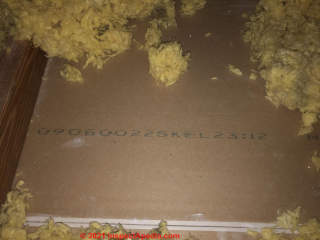
@Jeff, thanks; do let us know the test result as that will help other BC and other Canadian readers.
thank you for taking the time to post your opinion on my question. I will send a few samples off before proceeding
@Jeff,
Here is what we know about ASBESTOS in CANADIAN DRYWALL https://inspectapedia.com/hazmat/Asbestos-in-Canadian-Drywall.php
In a 1975 house, unless you know this drywall is from the 1996 renovation, you'd treat it as presumed to contain asbestos - or if that means facing a big cost, have samples of the drywall AND of joint compound tested for asbestos
You can find ASBESTOS TEST LABS in the ARTICLE INDEX
@Jeff, here is another pic
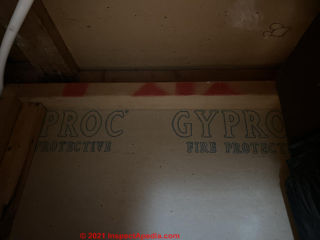
Hi, I'm currently starting a Reno on my home and have come across some gyproc that I don't want to mess with until I have a better idea of whether or not it might contain asbestos. Any insight is appreciated. House was built in 1975 in Victoria bc Canada, and had some sort of Reno in 1996.
Thanks in advance
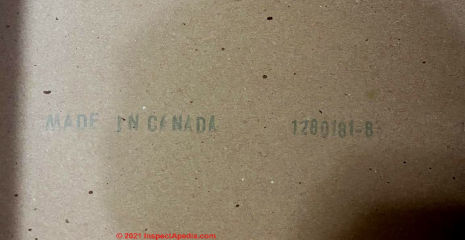
@Chris bridges, the chances that your fire-rated drywall contain asbestos are good if it was made in North America before ca 1986

@Den Clark,
Also see Canadian DOMTAR Drywall
https://inspectapedia.com/interiors/Drywall-Identification-Stamps.php#Domtar
Yes, the house was built around that time.
I appreciate you taking the time to answer. Thank you.
@Den Clark, I can't identify the manufacturer of your drywall although it's certainly likely to be a Canadian one. From the number I suspect that it was manufactured in 1986. Is that consistent with the age of the building where it's installed?
I am trying to indentify if some drywall we have from a house we bought in BC Canada has asbestos. There is a stamp on the back but no other id marks on the back or sides. I have attached a photo. The number as I read it is 8612160631B Any assistance is appreciated. Thank you.
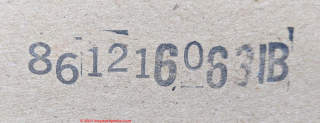
will most surely do that! I will get specifics/dates and include that information
Thank you for the follow-up, Jennier; I'm glad to offer what assistance we can, without bias as that makes it more-useful;
working together makes us smarter.
If you have dates or references for the Lafarge sale to Continental Building Products and for the subsequent sale to CertainTeed those would be helpful to add here (this page)
or at DRYWALL & GYPSUM BOARD COMPOSITION & HISTORY - composition & History
https://inspectapedia.com/interiors/Drywall-Composition-History.php
I can't even begin to thank you for all the research you performed on my behalf. It provided help beyond measure. I did discover the owner of the UPC code is Lafarge Corporation who sold their gypsum board business to Continental Building Products. It was then sold to CertainTeed. I am trying to get information from them now. Thank you again @danjoefriedman. Every bit of info and detail and resource your referenced made this painful, stressful task where I was completely at a loss and had no understanding of until no so easy.
Jennifer
Please find your recently-posted question(s) or comments and photos along with our reply now at the Reader Q&A section near the bottom of the article above on this page. You may need to clear or refresh your browser cache to see the updated page. We welcome your further photos, comments, questions.
I can't even begin to thank you enough for your reply. Our homebuyer of 2.5 years ago is suing us saying we hid structural issues beneath this gypsum board which they state was manufactured in 2008. We never installed any gypsum board and have been intimidated that this buyer (an attorney himself) is claiming that since we lived in the house in 2008 that this (based on the UPC code) gypsum wallboard was purchased and installed that year.
This is simply a lie. I didn't know how to research anything of this nature which is foreign to me. We hid nothing but were confused that he said he found this tag on the back of the gypsum board and it proved we installed it in 2008 which we didn't do at all
. We feel he is just trying to get us to pay for an expensive remodel (and the house is historic being built in 1844) All we ever did was apply two coats of paint during the years we lived in the house on the walls. One last question - based on the CSA number are you saying that the gypsum board was last withdrawn in 1991?
Jennifer
Thank you for the important and troubling question. I've done some additional research on the relationship of drywall identification stamps, standards, and UPC codes and their role in dating or setting thte age of specific drywall or gypsum board products.
The earliest drywall identification stamp I've seen was from 1894.
Dates of Drywall Standards: You'll see in recent comments on this page, that we can sometimes make a reasonable guess at the age range for a drywall product by noting the dates at which standards cited in a drywall stamp or imprint were first published or last withdrawn.
Patent research: And sometimes we use patent research to get a similar "oldest" or "newest" plausible age.
The use of UPC: Universal Product Codes found on drywall can set a "no older than" date in the U.S. as the mid 1970s. It might be possible to trace a specific UPC to a specific production lien of drywall made by a particular manufacturer, though often those UPCs are likely to appear on a product over quite a few years.
Those tools are reasonable in that no one could successfully argue that somebody put up drywall in 1954 that bears a standard ID or number that was first published in 1985.
But all of those analyses are accurate only to a range of dates, not to a precise date.
Corroborating Evidence of Drywall ID & Age: For that reason I typically advise readers who have some reason to care for a more-accurate date of any building material to review
- the original date of building construction
- dates of and records of building modifications
- the plethora of surrounding building age clues that we give starting at AGE of a BUILDING, HOW to DETERMINE - home
Pending further research on the use of drywall stamps, I note that my OPINION, having looked at this topic for some years now, is that there is not consistent use of drywall stamps and identification markings; there is wide variation in when product information is applied and also how it is applied: ink stamps, paper labels, tear-off strips on the bottom edges of drywall, etc.
It varies considerably by manufacturer.
But I can assure you that while we may find gypsum board or drywall that bears no identification mark, for at least some manufacturers, product identification stamps have appeared on the back side of lots of drywall in the U.S. since 1912 or earlier.
Those stamps, as you'll see in this article series, appear in a wide range of formats, colors, and vary considerably in what information is provided. Some, not all, include reference to fire or other classifications.
What is the actual issue here? Can we get that clarified? If so we might conclude that the age of the drywall is completely irrelevant or there may be other more-direct methods of answer the question of who did what when to the building.
Also see the historical data on drywall composition and uses at
DRYWALL & GYPSUM BOARD types, age, history.
The first use of UPCs or Universal Product Codes in the U.S. was in 1974. Source: "The History of Barcodes" - https://www.barcoding.com/ where we read that barcode readers have been in use in the U.S. since 1952, and that UPCs came into first use 22 years later.
What I take from this is that if drywall in your home bears a UPC, from that information alone, that is without tracking down the specific drywall manufacturer's use of a specific UPC Number, the drywall could be as old as the 1970s.
Finally: from what you've told me, and without any onsite data, I'm tempted to reply to the current owner's attorney: "You're just fishing, and ... there's no fish in this water."
Regarding gypsum board dating, can the moderator comment on what the standards are for date stamping and manufacturer on the back of it. A home buyer of ours from years ago is suing us for fraud saying we put up drywall to hide defects stating that "based on the UPC code" it was purchased in 2008 or later when we resided in the house.
The home buyer is a less than scrupulous attorney who seems to be pulling out whatever stops he can for us to pay for his expensive renovation of a home dating back to 1844 - bee hive ovens and all.
We lived in the house for 16 years and the only thing we ever did to the drywall that existed on those walls when we purchased the houses was update colors twice. Can the moderator or anyone else who has knowledge kindly weigh in on how drywall can be legitimately dated and is it standard in the industry (and for how long) that dry wall be date stamped in the United States? We are truly at a loss.
While we realize that we did not install this board, when this buyer intimidates us through UPC codes stating it was manufactured in 2008 or later it makes no sense. We didn't install drywall. Can anyone kindly weigh in on this? In my research I learned that certain markings started in 2011 and 2012 due to a drywall act, but was it standard in the industry that drywall as far as thirty years back could have a date stamp/manufacturer on the back? So many thanks
Jennifer:
I'm not saying that gypsum board itself was last withdrawn in 1991. I'm saying this:
If a building standard was withdrawn in 1991, and if drywall bears a stamp saying that the product complies with a now-withdrawn standard, the MOST LIKELY (but not absolutely certainly) the drywall was manufactured before that withdrawal date.
My reasoning is that a manufacturer is more-likely to stamp their drywall with references to standards that are active at the time the drywall was manufactured.
The reason I emphasized "most likely" is because I am not aware of anyone who is policing the timeliness of or use of drywall stamps by manufacturers. To get further on this question you'd need to contact the specific manufacturer of your specific drywall and find someone who knows how that producer uses and applies product stamps, and then get them to clarify exactly when they stop using or update the text in the stamps they put on their products.
An alternative, more-forensic approach to answering the assertion by someone that drywall in your building has been removed and replaced might be possible by observing variations in drywall fasteners and in nail or screw hole patterns in wall studs that might be exposed when the current drywall is removed.
For example, , during its long life, the wall coverings in your home were changed just once from plaster to drywall, then when we remove the current (and old) drywall we might see on the faces of the studs the marks where plaster and lath were removed, and we might see a single set of matching screw or nail holes that fit exactly the drywall that has just been removed.
Of course nothing would prevent there having been multiple generations of drywall installed, removed, installed-new in a home that is more than 150 years old!
- home buyer claims cover up is "proven" by drywall date stamp
I can't even begin to thank you enough for your reply. Our homebuyer of 2.5 years ago is suing us saying we hid structural issues beneath this gypsum board which they state was manufactured in 2008.
We never installed any gypsum board and have been intimidated that this buyer (an attorney himself) is claiming that since we lived in the house in 2008 that this (based on the UPC code) gypsum wallboard was purchased and installed that year. This is simply a lie.
I didn't know how to research anything of this nature which is foreign to me. We hid nothing but were confused that he said he found this tag on the back of the gypsum board and it proved we installed it in 2008 which we didn't do at all.
We feel he is just trying to get us to pay for an expensive remodel (and the house is historic being built in 1844)
All we ever did was apply two coats of paint during the years we lived in the house on the walls.
One last question - based on the CSA number are you saying that the gypsum board was last withdrawn in 1991?
Jennifer:
Here's a clever detail: C36/C36M-03e1 Standard Specification for Gypsum Wallboard was withdrawn in 2005, so while we don't know when your particular piece of drywall (gypsum board) was manufactured, it's reasonable to GUESS that it was in or prior to 2005. [OR that the manufacturer has not updated their product labeling. ] Source: ASTM, https://www.astm.org/Standards/C36.htm
ASTM C1396 / C1396M - 17 Standard Specification for Gypsum Board remains active.
The other standards cited CSA A82.27 was published in 1991 and has also been withdrawn.
CAN/CSA-A82.27-M91 Gypsum Board Covers requirements for gypsum board designed for use with or without the addition of plaster, for walls and ceilings. Status: Withdrawn - source: https://www.scc.ca/en/standardsdb/standards/4876
NYC BSA#682-56-SM a New York City drywall standard is, unfortunately far more difficult to research thanks to the similarity to BSA - Boy Scouts of America
Can someone tell me the dates of production of this particular gypsum board? Would anyone know if gypsum board is required to be date stamped on the back? Thank you very much.
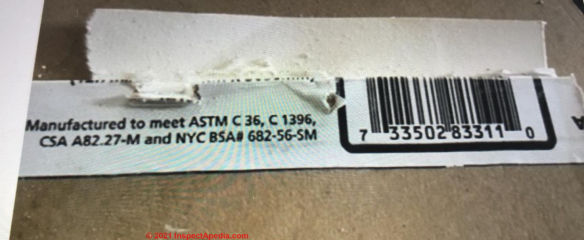
Ben
When you see fire resistant gypsum board or wallboard from before 1980s you must consider that it may contain asbestos as might the drywall compound used on the board joints. To know for certain you would need to have representative samples tested.
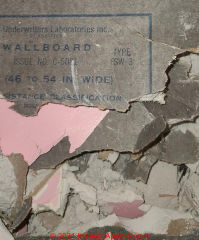
Just wondering if this contained asbestos.
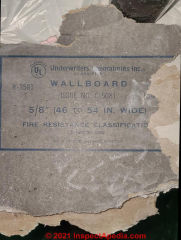
Rob: any other stamps or markings? Patent nos. ?

@rob,here is a picture of the stamp on side [above]
We are doing renovations on our 94-95 built cabin..so the drywall should be around this period.
It is from WINROC and a has that company name on edges and barcodes like 726770133 and on side too is a stamp like attached.
So hope I am asbestos free and can take to dump and show this info? comments?
The patent numbers are 1029328, 1034746, 1330413, 1358508, and 1383249.
The house is in a fairly remote mountain area of Placer County, California.
The county assessor dates my house at 1932 but it and the parcel weren't taxed separately from the parcel it was subdivided from in 1931until 1964. The house was built out of a deconstructed 1897 hotel.
Newspaper mentions document that the hotel was taken apart in 1907 so I know the house was built after 1907. Photos of the construction groundbreaking show the original owner/builders in clothing characteristic of the 1920's and a later photo shows the house with very mature vegetation and a vehicle with 1938 registration.
The house was built by a longtime company superintendent and the land that was deeded to him and his wife was part of the greater property and business he managed for them. In the industry it was typical for employees to live on the company property and I suspect the house was built before he was deeded the property.
It's difficult to know if later patents would be attributed to that product and USG doesn't have a historian or archivist to help with dating it. Sorry to be vague about the location and company's industry, it is somewhat unique so, for security purposes, I don't want to publish that. Thank you
Does anyone know anything about 'Truroc Gypsum'.
There are two visible numbers on the sections I am able to see.
7H28U7
7I06V8
It appears to be 1/2 inch and the house is of the age that there is likely asbestos. Wondering what the fire rating on this gypsum would be (ie. wondering if half inch drywall with asbestos is more fire retardant that drywall with no asbestos)
S.T.
Thank you for the photo and question about US Gypsum Sheetrock - "fireproof wallboard". I'll see what else I can find and would like to know what other indicators you've used to narrow the age to between 1907 and 1932.
You used one of my favorite tricks to look into the age of this material: patent number research. The 1921 patent means that the oldest this sheetrock could be is 1921.
Tell me the location: country, city, and what you can about the building where it's installed.
Please also tell me all of the patent numbers, as the photo is a bit blurry even at full size.
Hello and thank you for the informative site!
I'm looking to find any information about the Sheetrock that appears to be part of the original design and build of my house. The house was built with all recycled lumber and, at this time, the Sheetrock is the only material I can identify that might be able to date when it was actually built. Other indicators have only narrowed it down to between 1907 and 1932!
It is 1/4 inch USG Sheetrock with a light orangish color label running the length of the panels. The latest patent date listed on the label is for a 1921 patent. There are no other labels visible and no date stamps to be seen. Any information on dating this product would be greatly appreciated.
Thanks in advance!

I have a house in California that was constructed out of used lumber with its interior finished in 1/4 inch Sheetrock.
I'm interested in figuring out about when the house was built. The Sheetrock appears to be original to the house's design plan. Any help with dating the Sheetrock would be much appreciated.
It has an orange colored label running lengthways on the panels with the latest patent number being for a1920 patent. There are no other labels visible anywhere and no date stamp to be found.
Thanks in advance!
I have a drywall board I can not identify. Please help. It only has 1116-1225-1004 RCD
Anyone know what this means?
Savannah,
I think the number that you are citing from drywall is probably a production run number or possibly production date. Unfortunately I can't identify the manufacturer or specific product from that alone. It'll be prudent to treat the drywall is presumed to contain asbestos which means that it's perfectly safe to leave it in place as long as you're not doing a demolition and creating a Dusty mess.
hi there so we are looking around our house built in 1975 and I found what I believe to be original drywall and it says best wall the # on it is 071004xm. Does anyone have any data on this? I haven't been able to find anything on this. TIA
Hi, I'm trying to find out if my drywall contains asbestos. This is the number stamped on the back: 12061SYB1. Any help would be appreciated.
Those are probably patent no. dates, Annie.
Sure, the home could be older than those dates.
Hi, I found this drywall while renovating my house. I really need to establish the construction date of my house and I don't know what to think of all these years. Should I consider the last date, or could it be older than the last date? Many thanks!
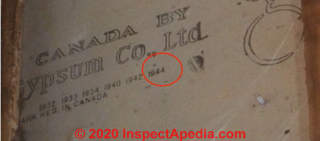
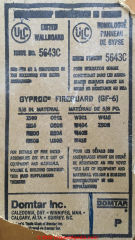 Duane
Duane
please take a look at DOMTAR GYPROC ASBESTOS? https://inspectapedia.com/hazmat/Asbestos-in-Canadian-Domtar-Drywall.php
and don't hesitate to ask follow-up questions
Trying to determine if old drywall contains asbestos. Part number on one sample is C060983-17
Anon
GPFS-3 may be a Georgia Pacific drywall product, and FS could be fire-resistant - I tried searching the GP site without success but you might give them a request message at https://www.buildgp.com/contact-us/
wallboard is stamped "TYPE GPFS-3" and "ISSUE NO. B-2721". I need to figure out what kind of drywall this is.
Anon, as the Add Image button doesn't accommodate documents or other forms, please use our email found at the page top or bottom CONTACT link
Thanks
And thanks for the important follow-up
Dan, I sent my sample in for testing regarding the wallboard with the orange patent numbers and it came back negative. The report is added.
Thanks for that helpful update, Quetzo, I've added your note into the article above.
In response to the (mod) who took a look at the pics of my board with no fire-rating stamps of any kind on it - the house is located in vancouver, bc, canada, and the install happened likely before 1986 (so 34 years old now). The home is 97 years old, built 1923. Not sure that helps...?
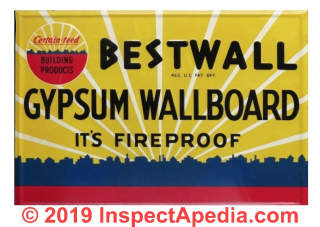 Thanks for the images, Nick/Oswana21
Thanks for the images, Nick/Oswana21
In addition to adding them to the DRYWALL IDENTIFICATION STAMPS page I'll include what you've provided at
BESTWALL DRYWALL ASBESTOS
where I've made a separate page for Bestwall and its history.
Your photos show by edge view what looks like a paper covered gypsum board so it's not likely that your wallboard is the earliest (sawdust and gypsum-based) version of BestWall - as we guessed, perhaps from the 1950s or even later.
If you are able to find a stamping specifically saying "Bestwall" that would be helpful.
I can't make out all of the text in your images; if you can translate it do let me know what it says - as much as you can.
Patent numbers are also helpful for research.
I did see the words New York on one of your stamps.
Bottom line: treat the drywall as presumed to contain asbestos or have a sample tested.
Your gypsum board may be quite old - dating probably from the 1930s to 1950s. Certainteed purchased Beaver Products in 1928.
Certainteed's Bestwall Gypsum board contained asbestos through 1976 or possibly 1977 depending on when the product installed in that year may actually have been manufactured. You should also consider that joint compound used with the product may also have contained asbestos.
Recently began to take down some old gypsum and I noticed that it said "Certain-Teed Beaver Gypsum Fireproof. Does anyone know anything about this?
I can't say for sure if that gypsum board contains asbestos, but indeed some detail about the CAN/CSA standard A82.27 addresses fire-rated gypsum board, SOME of which products, depending on when they were made and by whom, could contain asbestos.
I think that's a Type C gypsum board.
Type C fire rated drywall (sometimes referred to as Improved Type X) is similar in composition to Type X, except that it has more glass fiber reinforcement and other ingredients in the gypsum core that makes its fire resistive properties superior to Type X.
Type C gypsum board is available in 1/2-inch (12.7 mm) and 5/8-inch (15.9mm) thicknesses. - source FIRE RATED GYPSUM, Certainteed https://www.certainteed.com/drywall/what-fire-rated-gypsum/
It would be helpful to know the age of the product or at the very least the age of the building where it was installed and a guess at when it was installed.
CAN/CSA-A82.27-M91
Gypsum Board
Covers requirements for gypsum board designed for use with or without the
addition of plaster, for walls and ceilings.
Status: Withdrawn
SDO: CSA
Language: English
Publish date: 1991-06-30
Supersedes: A82.27-M1977
Keywords: BOARDS, COMPOSITION, CONSTRUCTION MATERIALS, GYPSUM, PHYSICAL TESTING,PLASTERBOARD, STRENGTH OF MATERIALS, SURFACE TREATMENT, WALLBOARD
ICS Codes: 91.100.10;
Standard Number: CAN/CSA-A82.27-M91
See details at CANADIAN DRYWALL ASBESTOS
AND
CANADA ASBESTOS REGULATIONS
Hey all, Enjoyed looking through the pics to see if my boards are similar, but no!
Trying to determine if this can safely go in a landfill or needs asbestos/hazardous waste protocol...? Pulling down various drywall bits from renos over the past 10~30ish years in a 97 yr old house in Vancouver, BC, Canada.

Above: Text: 85V332W08 MADE IN CANADA
Below: Another pic of a diff type of drywall board... same reno. Thanks. Text: BORD AMINCI ... 2424 Chemin Lakehorse Quest., Mississauga, Ont. L5J 1K... ... POUR SUPRASSER LES NORMES CANSA-A82.27 et ASTM ...
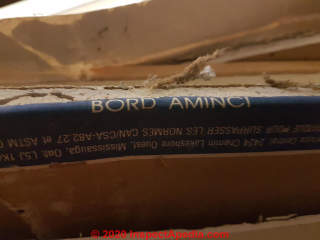
If you don't see a UL classification, a Type X or Type C or U495 and V416 stamp,
Then I would assume that the drywall is not fire rated or that it was made before those US stamps and datings were used.
It would be helpful to know the country and city where the drywall is located and the age of it or at least the age of the building.
I don't think those characters identify the manufacturer explicitly but probably do identify a production plant and perhaps encoded date and time.
If you don't see a UL classification, a Type X or Type C or U495 and V416 stamp,
Then I would assume that the drywall is not fire rated or that it was made before those US stamps and datings were used.
It would be helpful to know the country and city where the drywall is located and the age of it or at least the age of the building.
On 2020-01-21 Reader Follow-up re the drywall above: no asbestos - Vancouver BC
In response to the (mod) who took a look at the pics of my board with no fire-rating stamps of any kind on it - the house is located in Vancouver, BC, Canada, and the install happened likely before 1986 (so 34 years old now). The home is 97 years old, built 1923.
Trying to identify the fire rating for this dry wall these are the only makings I could find.
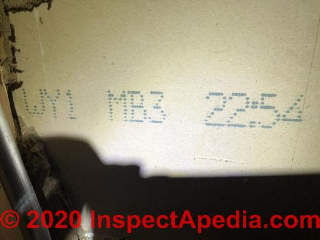
Hello,
I cannot find any information on this specific type of sheetrock made by USG. I am concerned it contains asbestos (I understand i need to have it tested)
It is called Woodgrained Sheetrock - Fireproof Gypsum Wallboard - This would have been installed in 1955.
Please see the photo below. I was hoping someone has seen this product label from 1955 before and let me know if they know more about this product.
IMAGE LOST by older version of Comments code - now fixed. Please re-post the image if you can. Sorry. Mod.
Can anyone identify the date of manufacturing from a stamp on the back of drywall that appears thusly:
Caledonia East 88 02 22 02 26 B
IMAGE LOST by older version of Comments code - now fixed. Please re-post the image if you can. Sorry. Mod.
Ellen
I could just make out a big red e. Not the rest of the text. It is a stamp that I have not seen before so I'm not sure who's drywall or gypsum board that is. If you can remove pieces without making a Dusty mess you're pretty safe in any case.
If you've read these articles you know that the main Hazard is in the joint compound and in particular if you use a power saw or grinder or sander.
If I had to remove a piece of drywall like that I would probably use a utility knife and pull it from the wall using an approach that did not break it into pieces and I would certainly not use a power saw. You can also reduce hazards by wedding.
And you can also clean up dust by HEPA vacuuming
Hi
I'm trying to check my drywall before I remove it. There is a small inspection hatch.
I could not see any brands , just 6 inch high red letter
E38192s
IMAGE LOST by older version of Comments code - now fixed. Please re-post the image if you can. Sorry. Mod.
...
Continue reading at DRYWALL & GYPSUM BOARD COMPOSITION & HISTORY or select a topic from the closely-related articles below, or see the complete ARTICLE INDEX.
Or see these
Recommended Articles
- ASBESTOS CEMENT CEILING & WALL PANELS
- ASBESTOS in DRYWALL
- ASBESTOS in PLASTER - what about the use of asbestos in plaster walls & ceilings?
- DRYWALL, FIBERBOARD, PLASTER INTERIORS - home
- DRYWALL IDENTIFICATION STAMPS
- DRYWALL & GYPSUM BOARD COMPOSITION & HISTORY - composition of drywall & drywall history
- GYPSUM BOARD GYP ROCK SHEATHING
- GYPSUM BOARD PLASTER LATH SYSTEMS
- PLASTER INGREDIENTS, MIX, COMPONENTS
- PLASTER TYPES & METHODS in BUILDINGS
- PLASTER COATING LAYERS
- FIBERBOARD PLASTER BASE SYSTEMS
- GYPSUM BOARD ROCK LATH SYSTEMS
- METAL LATH PLASTER LATH SYSTEMS
- MASONRY SURFACE PLASTER
- PLASTER & GYPSUM BOARD HISTORY & RESEARCH
- PLASTER REPAIR METHODS
- SACKETT BOARD
- WOOD LATH for PLASTER or STUCCO
Suggested citation for this web page
DRYWALL IDENTIFICATION STAMPS at InspectApedia.com - online encyclopedia of building & environmental inspection, testing, diagnosis, repair, & problem prevention advice.
Or see this
INDEX to RELATED ARTICLES: ARTICLE INDEX to BUILDING INTERIORS
Or use the SEARCH BOX found below to Ask a Question or Search InspectApedia
...
Ask a Question or Search InspectApedia
Questions & answers or comments about ages & types of wall & ceiling materials, installations & practices.
Try the search box just below, or if you prefer, post a question or comment in the Comments box below and we will respond promptly.
Search the InspectApedia website
Note: appearance of your Comment below may be delayed: if your comment contains an image, web link, or text that looks to the software as if it might be a web link, your posting will appear after it has been approved by a moderator. Apologies for the delay.
Technical Reviewers & References
Click to Show or Hide Citations & References
Publisher InspectApedia.com - Daniel Friedman
Design Stamp for Use on Dry Wall
Source: https://inspectapedia.com/interiors/Drywall-Identification-Stamps.php
0 Response to "Design Stamp for Use on Dry Wall"
Postar um comentário